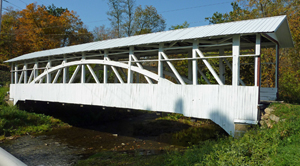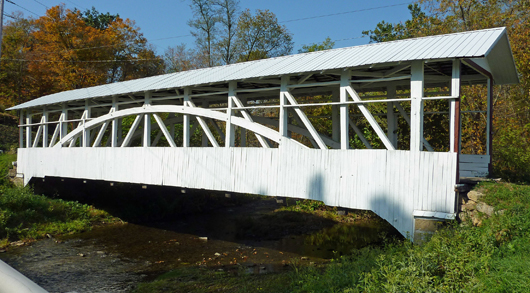
BEDFORD, Pa. (AP) – Eighty-two-thousand dollars for a fresh coat of paint.
Few homeowners would tolerate such a bill, but in Bedford County, it’s a typical expense for the century-old covered bridges that seem to cross every creek and stream.
With 19 covered bridges owned by the county and nine still used regularly by drivers, Bedford ranks among Pennsylvania’s top counties for the historic spans. Hearkening to the time when farmers rode horse-drawn buggies to town, the bridges are a major draw for tourists – 12 are on the National Historic Register – but they need frequent, and often expensive, maintenance.
In the next few days, work is set to begin on one covered bridge at a $204,000 price tag, while another will likely call for about $325,000 in federal and state money, Commissioner Chairman Kirt Morris said. For one, the Jackson’s Mill Bridge near Breezewood, the average bid for the paint job alone was $82,000.
“Bridges are an expensive asset … and covered bridges are a very high-maintenance item,” Morris said at a meeting last week. “But you know how many streams, creeks, rivers we have in Bedford County. You can’t travel far without crossing a bridge.”
Built mostly through the 19th century as a means to lengthen the lifespan of wooden river crossings, covered bridges stand among the most recognizable symbols of rural America. Whole communities of preservation activists have formed over the decades, particularly in Pennsylvania, which boasts far more covered bridges than any other state.
“Perhaps no other image comes to mind more when you mention Bedford County than covered bridges,” literature from the Bedford County Visitors Bureau reads. Of the self-guided tours the bureau offers, the bridge tour is the most popular, according to its website.
But their beauty and history come with a price: Built mostly or completely of wood, they rot away while other bridges don’t, and without added support, they often can’t carry anything much heavier than a family car.
When they need repairs, painstaking work is required to follow historical guidelines, with plans subject to approval from the Pennsylvania Historical and Museum Commission, said county bridge engineer Aaron Craig of P. Joseph Lehman Inc.
Even simple work like stripping old paint can be tough. Since many of the 19th-century bridges used toxic lead paint, workers have to ensure not even a single strip falls into the water below, Morris said.
That difficulty leads to hefty bills, with the Jackson’s Mill Bridge’s average $82,000 bid for paint in the standard range, Craig said. With nine of the county-owned bridges in need of regular inspection and work recommended once every 10 years, the cost quickly adds up.
“You could easily be seeing $50,000 to $100,000 just in painting every year,” Craig said.
At Jackson’s Mill, locals have done their part to keep the site in order and have mown nearby grass, Morris said. But a rotting, exposed portion must be replaced, and it will take a hefty sum in the county’s state-issued liquid fuels fund to pay for the repairs.
For those that see regular traffic – like Jackson’s Mill, the only river crossing for miles for some residents – state highway money can cover the costs. Last year’s hike in the state gas tax could provide bonus funding for work officials had long delayed.
“If it didn’t make the bridge structurally deficient, we were putting it off,” Morris said.
In the 1990s, Bedford County reinforced many of its covered bridges with steel, preserving several for traffic while other counties, like Lancaster, posted restrictive weight limits and left them as they were.
For other bridges, including those maintained purely for historic significance, counties must scrape for other ways to pay.
At the well-known Bowser’s Bridge near Osterburg, work totaling nearly $325,000 was covered only with a grant from the National Historic Covered Bridge Preservation Program, a federal transportation initiative. Others have received money from nonprofits like the Theodore Burr Covered Bridge Society of Pennsylvania.
Without federal aid, “we would have never been able to afford to do the work,” Morris said.
With the bridges recognized as a community treasure and subject to government restrictions, there’s little chance the expense will decrease. Cost-saving measures are available – Clearfield County has used jail labor for timber work, and Bedford County could use inmates for painting, Craig said in a message to the commissioners – but seven covered bridges are on deck for new paint.
“It’s out there,” Craig said of funding for the bridges. “It’s just not as easy to get your hands on the money at this point.”
___
Online:
___
Information from: Altoona Mirror, http://www.altoonamirror.com
Copyright 2014 Associated Press. All rights reserved. This material may not be published, broadcast, rewritten, or redistributed.
AP-WF-08-20-14 1521GMT
ADDITIONAL IMAGE OF NOTE


